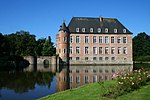
Oostkamp is a municipality located in the Belgian province of West Flanders. The municipality comprises the villages of Hertsberge, Oostkamp proper, Ruddervoorde and Waardamme. On January 1, 2019, Oostkamp had a total population of 23,698. The total area is 79.65 km² which gives a population density of 289 inhabitants per km².
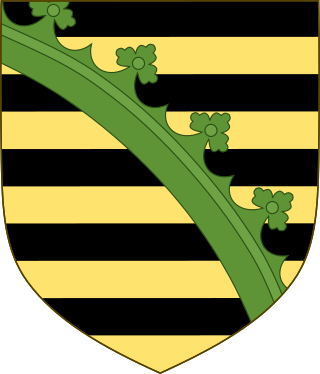
The House of Wettin was a dynasty which included Saxon kings, prince-electors, dukes, and counts, who once ruled territories in the present-day German federated states of Saxony, Saxony-Anhalt and Thuringia. The dynasty is one of the oldest in Europe, and its origins can be traced back to the town of Wettin, Saxony-Anhalt. The Wettins gradually rose to power within the Holy Roman Empire. Members of the family became the rulers of several medieval states, starting with the Saxon Eastern March in 1030. Other states they gained were Meissen in 1089, Thuringia in 1263, and Saxony in 1423. These areas cover large parts of Central Germany as a cultural area of Germany.
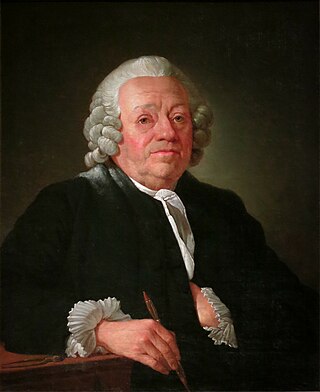
Jean-Nicolas Servan, also known as Giovanni Niccolò Servandoni was an Italian decorator, architect, scene-painter, firework designer and trompe-l'œil specialist.

Ooidonk Castle is a castle in the city of Deinze, East Flanders, Belgium. The castle is the residence of the current Count t'Kint de Roodenbeke. Ooidonk Castle is situated at an altitude of 11 meters.
The year 1766 in architecture involved some significant events.

The House of Hornes was an old and important European noble family, which became extinct in the male line in 1826. The name refers to Horn, a small village in Limburg, located in the Netherlands.
Henri Charles Francis Joseph Marie, 8th Duke d'Ursel was a Belgian film director and writer. Henri d'Ursel was known for his surrealist style, directing the film La Perle early in his career.

Westmalle Castle is located in the village of Westmalle, which is part of the municipality of Malle in the Campine region of Flanders, Belgium. Westmalle Castle is situated at an elevation of 29 meters.
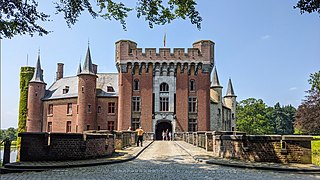
Wijnendale Castle is a historic residence in Wijnendale, West Flanders in Belgium which was once a medieval castle. The present buildings largely date to a nineteenth century restoration, though parts of the north wing still date to the fifteenth century. One wing is currently inhabited by the present owners of the castle, while another is open to the public as a museum.

The House of Arenberg is an aristocratic lineage that is constituted by three successive families that took their name from Arenberg, a small territory of the Holy Roman Empire in the Eifel region. The inheritance of the House of Croÿ-Aarschot made the Arenbergs the wealthiest and most influential noble family of the Habsburg Netherlands. The family's Duchy of Arenberg was a Sovereign State until it was mediatized in 1810. As such, the Arenbergs belong to the small group of families that constitute the Hochadel.

The Van de Werve family is one of the oldest Belgian noble families from Antwerp that is still in existence.
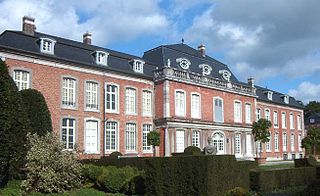
Heks Castle is a château in the village of Heks in the municipality of Heers, province of Limburg, Belgium.

The House of Ursel is the name of an old Belgian noble family of German origin. The Head of the House is styled as Duke of Ursel, while other members are styled as Count/Countess of Ursel.

Charles Joseph Marie, 6th Duke d'Ursel, was a Belgian politician.

Charles-Joseph, 4th Duke d'Ursel and of Hoboken, Prince of Arches and Charleville and Count of Grobbendoncq was a statesman and minister in the United Kingdom of the Netherlands and later Belgium.

Hingene is a village and deelgemeente (sub-municipality) of the municipality of Bornem in the province of Antwerp, Belgium. The village is bordered to the north by the Scheldt and to the east by the Rupel. It is located about 16 kilometres (9.9 mi) south-west of the city of Antwerp.

Conrad Schetz de Grobbendonck, later Conrad d'Ursel (1553–1632) was a nobleman in the Habsburg Netherlands and in 1604–1609 the first ordinary ambassador to England for the Archdukes Albert and Isabella.

Mesen Castle was an important noble residence in Lede, Belgium, today partly ruined and completely abandoned. The castle is considered to have been one of the most important aristocratic estates of the 18th century.

Charles Elisabeth Conrard, 2nd Duke d'Ursel and of Hoboken, Prince of Arches and Charleville and Count of Grobbendoncq (1717–1775) was a Duke from the Holy Roman Empire. He succeeded his father and became the second Duke of Ursel in 1738.

Robert-Marie-Léon, 7th Duke d'Ursel (1873–1955) was a Belgian politician.




















